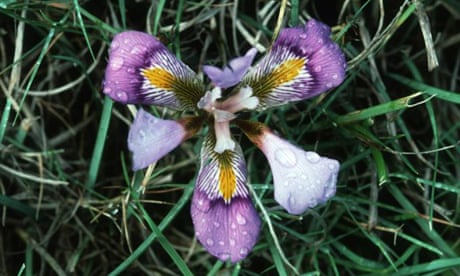A correspondent writes to suggest I should supply 'a few extra tips' on growing the Algerian iris. It seems a good idea. They are most obliging planters, even if maltreated, but a little extra kindness and understanding will bring forth an even better response. As is true of most of us, whether plants or humans.
Kindliness, so far as the Algerian iris is concerned, consists in starving it. Rich cultivation makes it run to leaf rather than to flower. What it really enjoys is being grown in a miserably poor soil, mostly composed of old lime and mortar rubble and even gravel: a gritty mixture at the foot of a sunny wall, the grittier and the sunnier the better. Sun and poverty are the two things it likes. To give it the maximum of sun to ripen itself off during the summer, you should chop down its leaves in May or early June and let the sun get at it for so long as our climate allows. There is no more that you can do for it except to guard it against snails and slugs. It is vital to do this if the flower is not to be nibbled and tattered by these creatures, which hibernate so happily within the leaves and in the cracks of the wall. Any proprietary slug-bait will do the job for you, or you can make your own mixture which is far cheaper and just as efficacious, with Meta tablets, smashed into a fine powder and mixed with bran, tea-leaves, or even sawdust. It may be unkind to the snails, but one has to make one's choice.
The Algerian iris is known to most of us as Iris stylosa. It should, in fact, be called Iris unguicularis, because this is the older botanical name for it, unguiculus meaning a small or narrow claw. Do we have to bother about that? Let us, rather, record that it is the native of stony ground in Algeria, Greece, Crete, Syria, and Asia Minor, and that it accommodates itself very willingly to our island, flowering before Christmas sometimes, especially after a hot, dry summer and continuing to flower in mild weather right into March. You should search your clumps of the grass-like leaves every day for possible buds, and pull the promising bud while it still looks like a tiny, tightly-rolled umbrella, and then bring it indoors and watch it open under a lamp. If you have the patience to watch for long enough, you will see this miracle happen.
If you have not yet got this iris in your garden and want to acquire it, you can plant it in March or April; but September is the best time for transplanting. It does not much like being split up and moved, so, whenever you acquire it, do make sure that it does not get too dry until it has had time to establish itself. After that, it will give you no trouble.

Comments (…)
Sign in or create your Guardian account to join the discussion